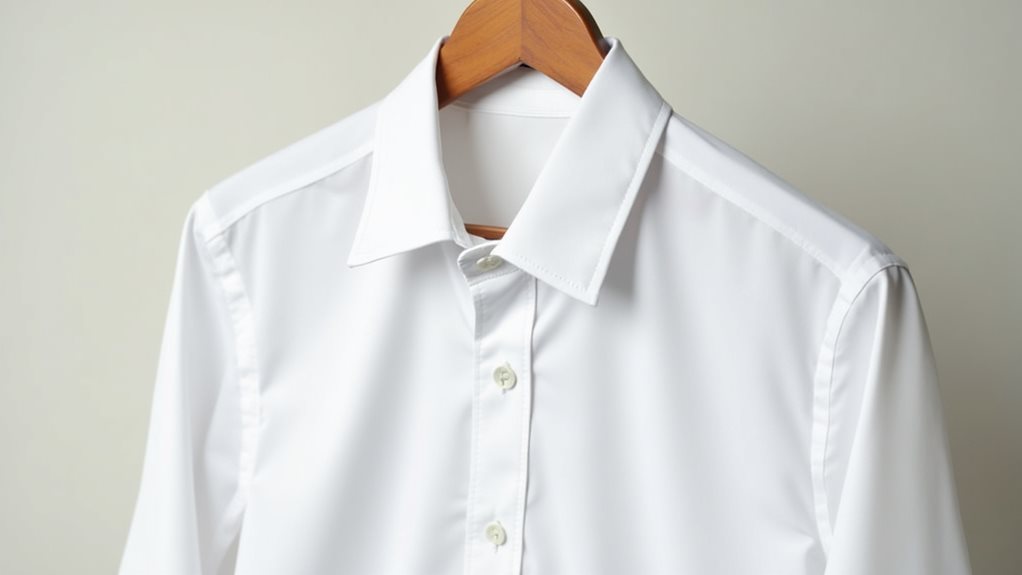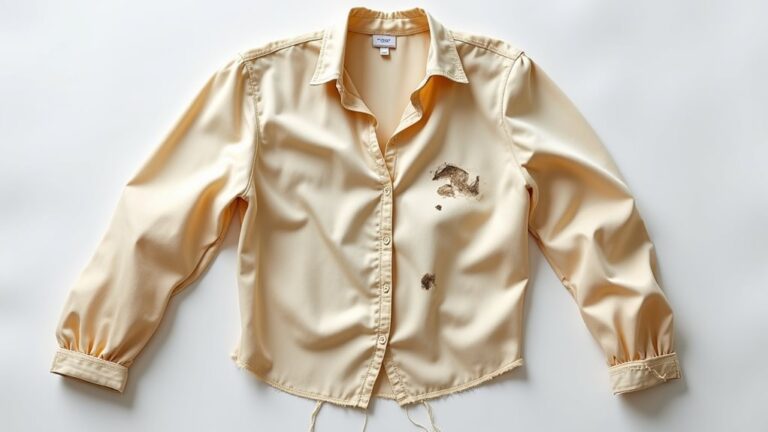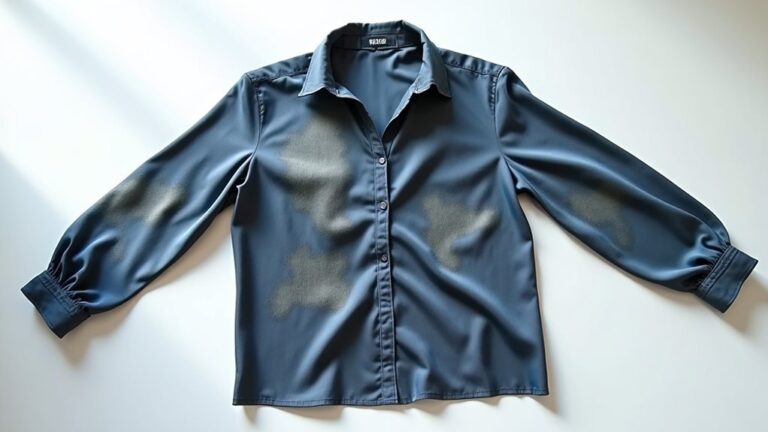Yes, dry cleaning absolutely works, especially for those frustrating oil-based stains that laugh in the face of your regular washing machine. The magic lies in perchloroethylene, a solvent that acts like a molecular magnet, attracting greasy makeup smudges and food stains that water simply can’t touch. It’s particularly brilliant for delicate fabrics like silk and wool, where water would cause shrinkage or damage, and modern machines recover 99.99% of the solvent for reuse, making the process both effective and environmentally conscious—though there’s much more to understand about when and why you’d choose this method.
What Is Dry Cleaning and How Does It Work
Although you’ve probably dropped off countless garments at the dry cleaner without giving it much thought, the process itself is surprisingly fascinating and operates on principles that would make your high school chemistry teacher proud.
The dry cleaning process relies on a liquid solvent instead of water, typically perchloroethylene (also called “perc”), which works like a molecular magnet for oil-based stains that regular washing can’t touch.
Perchloroethylene acts like a molecular magnet, attracting stubborn oil-based stains that water simply can’t dissolve or remove.
Your garments are cleaned through a systematic approach: first tagging and inspection, then pre-treatment of visible stains, followed by the actual cleaning cycle where the solvent circulates through delicate fabrics.
What’s brilliant is that modern machines recover 99.99% of the solvent for reuse, making it both economical and environmentally conscious—something I definitely didn’t appreciate until I understood the chemistry behind it! 😊
After the cleaning cycle completes, garments undergo solvent extraction and drying, then receive professional pressing and steaming to restore their original appearance, making this process particularly ideal for delicate fabrics like silk and wool that could shrink or lose their shape in traditional water-based washing.
The Science Behind Dry Cleaning Solvents
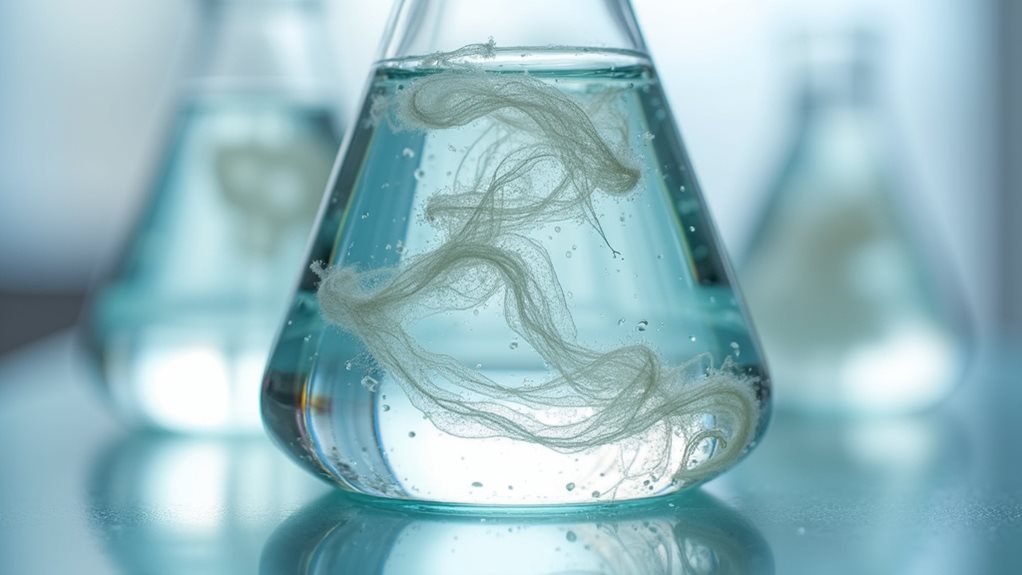
When I first learned that dry cleaning solvents work on completely different principles than your typical laundry detergent, it honestly blew my mind—we’re talking about a whole different category of chemistry that targets the molecular structure of stains in ways water simply can’t.
Perchloroethylene dissolves oil-based stains through gentle agitation and sophisticated solvent circulation, making it incredibly effective for delicate fabrics.
What’s fascinating is how modern machines recover 99.99% of solvents, dramatically reducing environmental impact.
Here’s what really excites me about this industry’s evolution:
- Eco-friendly options like liquid CO₂ are revolutionizing cleaning efficacy
- Biodegradable alternatives protect workers from harmful chemical exposure
- Advanced recovery systems minimize waste while maintaining effectiveness
The choice of solvent directly influences both safety and results, which is why I’m thrilled to see the shift toward greener solutions.
While petroleum-based solvents like perchloroethylene remain prevalent in many dry cleaning establishments due to their proven efficacy and established infrastructure, the industry continues evolving toward more sustainable alternatives.
Which Fabrics and Stains Benefit Most From Dry Cleaning
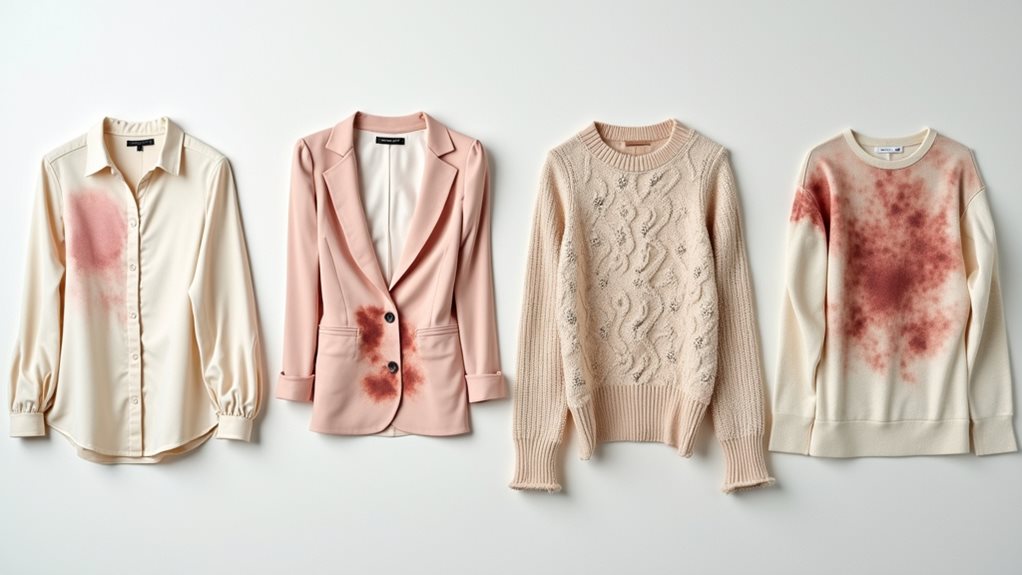
You’ve probably stared at that gorgeous silk blouse or wool coat, wondering if you really need to spend the extra money on dry cleaning, and honestly, I used to think it was just a fancy scam until I ruined my favorite cashmere sweater in the washing machine 😅.
The truth is, certain fabrics like wool, silk, velvet, and leather actually need those specialized solvents because water can literally destroy their structure, much like how my sweater went from fitted to tent-sized in one unfortunate wash cycle.
When it comes to stubborn stains from oil-based culprits like makeup, grease, or even that red wine you spilled during last week’s dinner party, dry cleaning’s chemical solvents can break down these messes in ways that regular detergent simply can’t match.
Additionally, garments with special construction features like structured blazers, beaded items, or clothing with complex linings require professional dry cleaning to maintain their shape and prevent damage from the agitation of conventional washing.
Delicate Fabric Requirements
While your cotton t-shirts can handle the rough and tumble of your washing machine, certain fabrics need the gentle touch that only dry cleaning can provide.
Think of delicate fabrics like silk, wool, and velvet as the prima donnas of your wardrobe—they’re stunning but require special attention to maintain their beauty.
These cleaning methods protect your investment pieces from the harsh reality of water damage:
- Wool sweaters won’t shrink into doll clothes when you trust professional solvent cleaning
- Silk blouses maintain their lustrous sheen instead of becoming dull, wrinkled disasters
- Beaded evening gowns keep their intricate embellishments intact rather than losing sparkles everywhere
Garments marked “dry clean only” aren’t being dramatic—they genuinely need structure preservation that traditional washing can’t provide, especially for oil-based stains.
Beyond protecting delicate materials, dry cleaning is particularly effective at removing oil-based stains, grease, and certain types of makeup that water-based cleaning simply cannot tackle.
Stubborn Stain Removal
Beyond protecting your wardrobe’s most precious pieces, dry cleaning becomes your secret weapon against those infuriating stains that mock your best home remedies, laughing in the face of your trusty stain stick and hot water combo.
When grease from that amazing pasta dinner decides to permanently relocate to your favorite blouse, or when makeup transfers onto delicate garments during those rushed morning routines, dry cleaning steps in where traditional washing methods wave the white flag.
The cleaning process works magic through pre-treating stains with specialized chemicals before introducing solvents that dissolve oil-based stains effortlessly.
Unlike water-based approaches that often set these stubborn stains deeper into fabrics, proper garment care through dry cleaning actually lifts them away, restoring your clothes to their former glory.
However, dry cleaning does have limitations with certain water-based stains like sweat and blood, where the solvent-based process may not be as effective as traditional washing methods.
Step-by-Step Breakdown of the Professional Dry Cleaning Process
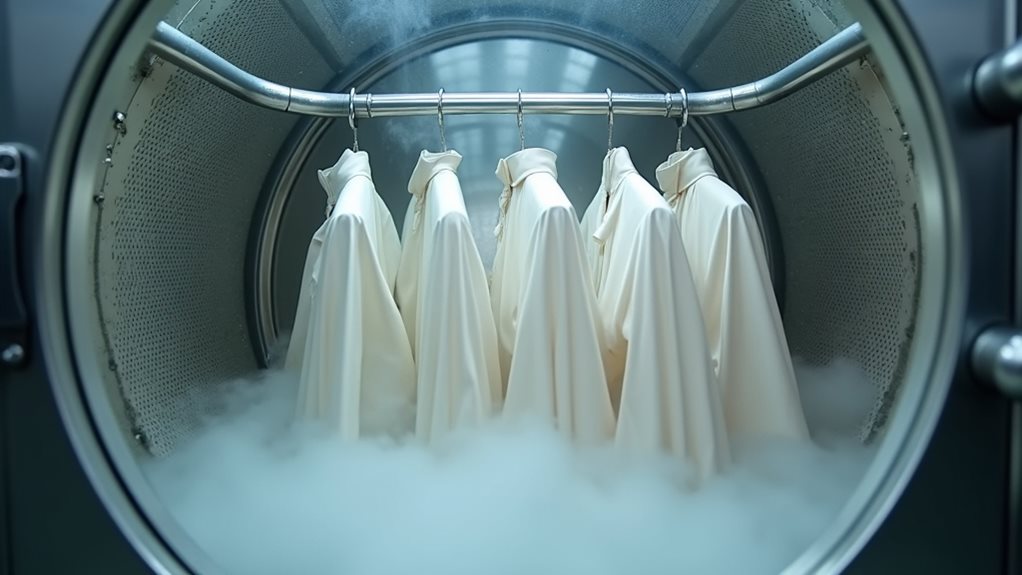
Five distinct stages transform your wrinkled, stained garments into pristine clothing through a carefully orchestrated dance that most of us never witness behind those mysterious curtains at the dry cleaner’s.
The professional dry cleaning process begins when your clothes receive unique tags, like hospital bracelets for fabric patients. Next comes inspection and pre-treatment, where stubborn stains get specialized attention before the main event.
Like patients entering a hospital, your garments receive identification tags before undergoing meticulous examination and targeted stain treatment.
Here’s what happens during the heart of cleaning involves using organic solvents:
- The solvent used gently agitates through fibers, working to remove dirt and stains without water damage
- Your delicate fabrics get pampered instead of pummeled 😊
- Every thread stays intact while grime disappears
The most commonly used solvent is perchloroethylene, though many cleaners are switching to more environmentally friendly hydrocarbon or silicone-based alternatives. After another quality inspection, garments are pressed back to their former glory, ready for your reunion.
Comparing Dry Cleaning Effectiveness to Traditional Washing
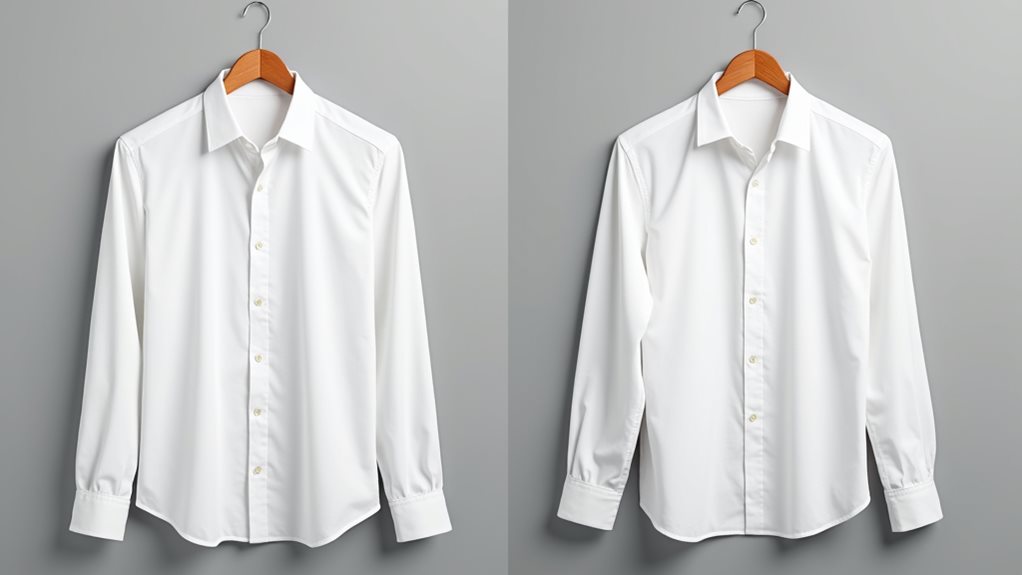
When you’re standing in your closet staring at that expensive silk blouse with a stubborn wine stain, you’ll quickly discover that dry cleaning and traditional washing aren’t even playing in the same league.
I learned this the hard way after ruining my favorite cashmere sweater in my washing machine 😅, which taught me that different cleaning methods excel at different challenges, from tackling greasy stains to preserving delicate fibers.
Understanding how these two approaches stack up against each other regarding stain removal power, fabric protection strategies, and overall cleaning effectiveness will help you make smarter decisions about caring for your wardrobe.
Dry cleaning uses chemical solvents like perchloroethylene instead of water, making it particularly effective at removing oil-based stains while preserving the integrity of delicate fabrics that would be damaged by traditional water-based washing.
Stain Removal Capabilities
While I used to think that tossing everything into my washing machine was the ultimate solution for any stain crisis, I’ve learned through some pretty embarrassing wardrobe disasters that dry cleaning operates on a completely different level when it comes to tackling stubborn marks.
The stain removal effectiveness of dry cleaning versus standard washing becomes crystal clear when you’re dealing with:
- Oil-based stains like makeup or grease that laugh in the face of regular detergent
- Delicate materials that need chemical solvents for deep cleaning without fabric integrity damage
- Stubborn marks requiring professional pre-treatment that your home washing routine simply can’t match
However, dry cleaning may struggle with water-soluble stains like sweat or blood, which is why many professional cleaners use additional water-based treatments when these types of stains are present.
Trust me, after ruining my favorite silk blouse with a DIY approach, I’ve learned that dry cleaning’s specialized techniques genuinely deliver superior results!
Fabric Protection Methods
Although I never gave much thought to how different cleaning methods actually protect my clothes until I started comparing garments I’d been washing at home versus those I’d sent to the dry cleaner, the difference in fabric preservation became undeniably obvious after just a few months.
Your delicate fabrics genuinely benefit from the solvent-based cleaning method because it doesn’t cause fibers to swell like water does when you wash clothes at home. This specialized approach tackles oil-based stains while maintaining your garment’s original shape and texture, something I learned the hard way after shrinking my favorite wool sweater 😅.
The fabric protection you get from dry cleaning extends garment life considerably, especially for items with embellishments that traditional washing might damage or loosen completely. Professional dry cleaning also provides expert pressing that creates a crisp, polished finish that’s nearly impossible to achieve with home ironing equipment.
Cleaning Process Effectiveness
How exactly does dry cleaning stack up against your regular washing machine when it comes to actually getting clothes clean? The dry cleaning process demonstrates superior effectiveness through specialized solvents used in dry cleaning, particularly when tackling stubborn oil-based stains that make your home washer throw in the towel 😅.
While traditional washing relies on water and detergent, professional cleaners employ targeted pre-treatment methods that identify specific stains before applying gentle agitation techniques.
Here’s where dry cleaning truly shines compared to your trusty washing machine:
- Delicate fabrics like silk and wool maintain their shape without shrinking or warping
- Oil-based stains dissolve completely instead of spreading or setting deeper
- Garment preservation extends your clothes’ lifespan through gentler cleaning processes
This cleaning effectiveness stems from continuous solvent filtration, guaranteeing each garment receives prime care. The process also involves extracting and distilling the chemical solvents for reuse while simultaneously drying the clothes, making it both efficient and environmentally conscious.
Environmental and Health Considerations of Dry Cleaning Methods
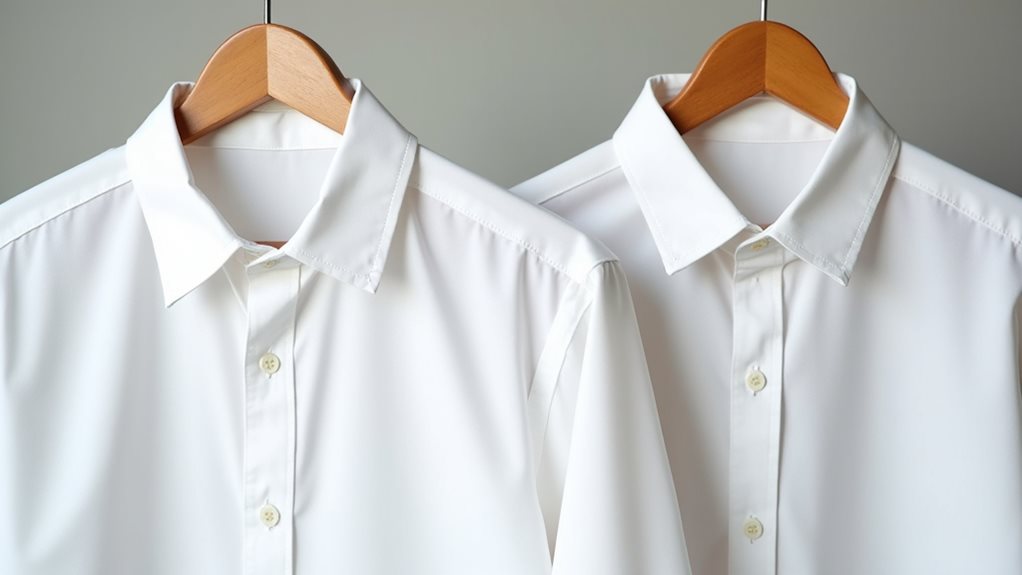
When I first started researching dry cleaning for this article, I honestly didn’t expect to stumble into what feels like a chemistry thriller complete with environmental villains and health scares.
The main culprit is perchloroethylene, a solvent that’s been linked to headaches, dizziness, and serious long-term health risks affecting your liver and kidneys. The EPA finally stepped in during 2020, phasing out perc from residential dry cleaning facilities because of these community health concerns and ecological risks.
Thankfully, the industry isn’t sitting idle—modern facilities use solvent recovery systems capturing 99.99% of chemicals for reuse, dramatically reducing environmental pollution.
Plus, there’s exciting momentum toward biodegradable alternative solvents like liquid carbon dioxide, making your clothing care choices safer for everyone.
Tips for Maximizing Your Dry Cleaning Results
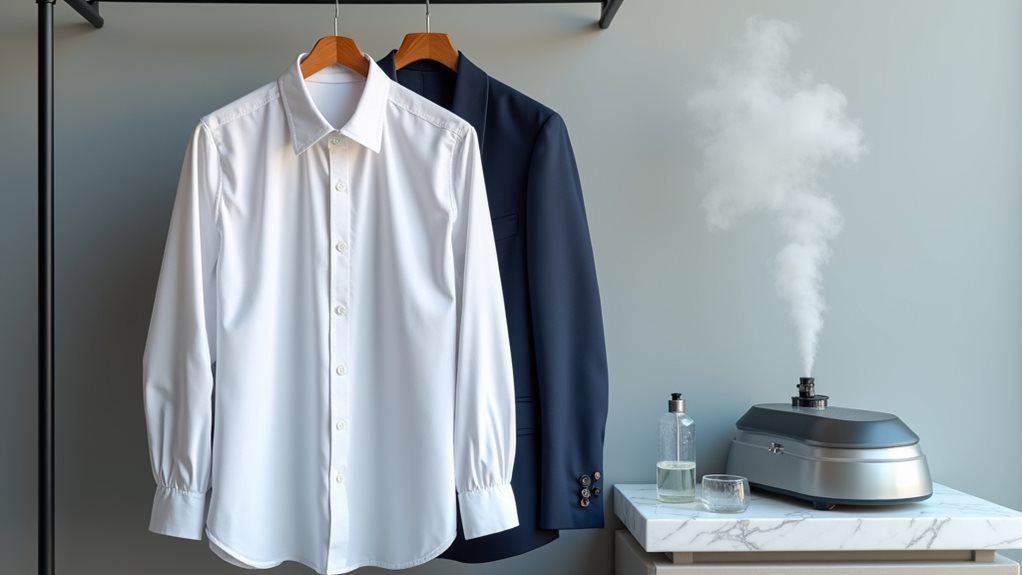
Why do some people seem to have clothes that always look crisp and fresh from the dry cleaner while others end up disappointed with mediocre results? The secret lies in understanding how to work with the cleaning process, not against it.
First, always check garment labels before assuming something needs professional cleaning – this simple step prevents costly fabric care mistakes.
When you drop off items, tell your trusted dry cleaner exactly what caused each stain, whether it’s wine, coffee, or mystery sauce from last night’s dinner.
Here’s what separates dry cleaning success stories from disasters:
- Never attempt DIY cleaning on dry clean only items
- Build relationships with quality cleaners for personalized service
- Schedule regular cleaning for frequently worn pieces
Smart preparation makes all the difference! 🧥

